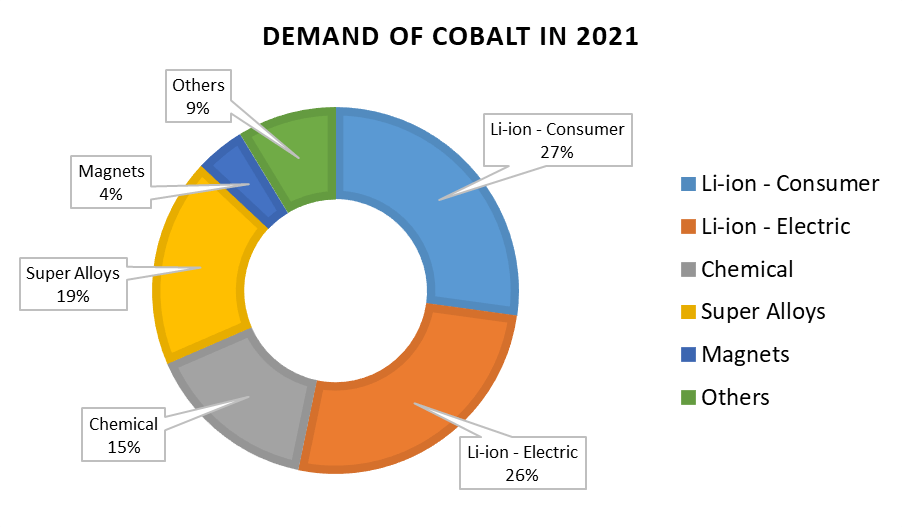Global Cobalt Market: Navigating The Unsettled Landscape After Congo's Export Halt

Table of Contents
The Impact of Congo's Export Halt on Global Cobalt Supply
The DRC's export suspension sent shockwaves through the global cobalt market, triggering immediate price volatility and supply chain disruptions.
Immediate Price Volatility and Market Reactions
The immediate aftermath of the export halt saw a dramatic surge in cobalt prices. Spot prices jumped by over 20% within days, reflecting the sudden scarcity of this crucial mineral. Major cobalt consumers, including leading EV manufacturers like Tesla and battery producers such as LG Chem and CATL, reacted swiftly, scrambling to secure alternative supply sources and reassess their production schedules. This price volatility created significant uncertainty, impacting investment decisions and profitability across the value chain.
- Price Fluctuations: Initial price spikes were followed by periods of increased volatility, making it challenging for businesses to accurately forecast costs and plan future production.
- Market Share Changes: Existing supply contracts were renegotiated, and some companies gained a competitive edge by securing alternative cobalt sources before the price surge.
- Financial Impact: The price instability created significant financial risks for companies with heavy reliance on cobalt, leading to increased hedging costs and reduced profit margins.
Disruption to the Supply Chain and Production Shortages
The impact extended beyond price volatility, causing significant disruptions to the supply chain. Downstream industries relying on cobalt for their production faced delays and potential shortages.
- EV Production Delays: Several EV manufacturers announced potential production slowdowns due to cobalt shortages, impacting their delivery schedules and potentially delaying their market penetration strategies.
- Smartphone Production Impacts: The electronics industry, another significant cobalt consumer, also experienced delays and increased costs, affecting the availability and pricing of smartphones and other electronic devices.
- Alternative Sourcing Challenges: Companies faced challenges in quickly identifying and securing reliable alternative cobalt sources, particularly those meeting ethical and sustainability standards.
Geopolitical Implications and International Relations
Congo's export halt has far-reaching geopolitical implications, impacting international relations and trade dynamics.
- Political Ramifications: The export halt highlighted the vulnerability of global supply chains reliant on a single major producer and emphasized the importance of diversification and robust risk management.
- International Intervention: International organizations are playing a crucial role in facilitating negotiations and seeking a resolution to the export halt, aiming to stabilize the market and ensure a consistent cobalt supply.
- Trade Disputes: The situation may lead to trade disputes and sanctions if the export halt persists, further exacerbating market instability and creating uncertainty for businesses.
Exploring Alternative Cobalt Sources and Supply Chain Diversification
Addressing the challenges posed by Congo's export halt requires a multi-pronged approach focused on diversifying cobalt sources, promoting sustainable mining practices, and exploring technological alternatives.
Identifying and Assessing Alternative Cobalt Producing Countries
Several countries possess significant cobalt resources, offering potential alternative sources.
- Australia and Canada: These countries are known for their robust mining regulations and relatively stable political environments, making them attractive alternatives to the DRC.
- Zambia and other African nations: Expanding production and improving mining practices in other African countries could help diversify the supply chain while promoting economic development in these regions.
- Production Capacity and Geopolitical Risk: Assessing the production capacity and geopolitical stability of alternative sources is crucial for mitigating supply chain risks.
Investing in Sustainable and Responsible Cobalt Mining Practices
Ethical sourcing and environmental responsibility are paramount in ensuring a stable and sustainable cobalt supply chain.
- Improving Mining Conditions: Initiatives focusing on improving working conditions, worker safety, and environmental protection in cobalt mines are crucial for ensuring ethical sourcing.
- Certification Schemes: Certification schemes and responsible sourcing programs can help trace cobalt from mine to end product, guaranteeing ethical and sustainable practices.
- Reducing Environmental Impact: Sustainable mining practices are essential to mitigate the environmental impact of cobalt extraction, minimizing water pollution, deforestation, and greenhouse gas emissions.
Technological Advancements and Battery Chemistry Innovations
Research and development in cobalt-free battery technologies offer a long-term solution to reduce reliance on cobalt.
- Cobalt-free Batteries: Significant advancements are being made in developing batteries with alternative chemistries, including lithium iron phosphate (LFP) batteries, which require minimal or no cobalt.
- Alternative Battery Chemistries: Investing in research and development of alternative battery chemistries is crucial for reducing reliance on cobalt and enhancing the sustainability of the EV sector.
- Adoption Timeline: While cobalt-free technologies are promising, their widespread adoption may take several years, requiring a multi-faceted approach to bridge the gap until then.
Strategies for Navigating the Unsettled Cobalt Market
Navigating the uncertainties in the cobalt market requires proactive strategies focusing on risk management, government policies, and industry collaboration.
Risk Management and Supply Chain Resilience
Mitigating cobalt price volatility and supply chain disruptions is crucial for business continuity.
- Hedging Strategies: Utilizing hedging strategies can help protect against price fluctuations and secure future cobalt supplies at predictable costs.
- Long-Term Contracts: Establishing long-term contracts with reliable suppliers can ensure a consistent supply of cobalt, reducing dependence on spot markets.
- Diversified Sourcing: Diversifying cobalt sources across multiple countries and suppliers reduces the risk associated with geopolitical instability and production disruptions.
Government Policies and Regulatory Frameworks
Government intervention can play a crucial role in stabilizing the cobalt market and supporting domestic industries.
- Supporting Domestic Industries: Governments can incentivize domestic cobalt production and processing to enhance national security and economic competitiveness.
- Sustainable Mining Regulations: Strict regulations on cobalt mining practices are crucial for ensuring environmental protection and worker safety.
- Fair Trade Practices: Promoting fair trade practices and transparency throughout the cobalt supply chain is essential for fostering sustainable and responsible development.
Collaboration and Partnerships Across the Value Chain
Collaboration between industry stakeholders is key to addressing market challenges and ensuring a stable cobalt supply.
- Information Sharing: Sharing information on market trends, supply chain disruptions, and technological advancements can help stakeholders make informed decisions.
- Industry Consortia: Establishing industry consortia or working groups can facilitate collaboration, coordinating efforts to ensure a stable cobalt supply.
- Joint Ventures: Joint ventures between mining companies, battery producers, and automakers can foster innovation and streamline the cobalt supply chain.
Conclusion: The Future of the Global Cobalt Market
Congo's export halt has exposed the vulnerability of the global cobalt market, highlighting the need for diversification, sustainability, and technological innovation. The immediate impact includes significant price volatility, supply chain disruptions, and geopolitical implications. Navigating the unsettled global cobalt market requires a multi-faceted approach. By investing in responsible sourcing, fostering collaboration, and embracing technological innovation, businesses can mitigate risks and ensure a secure and sustainable supply of this critical mineral for the future.

Featured Posts
-
 Us Egg Prices Drop To 5 A Dozen Relief For Consumers
May 15, 2025
Us Egg Prices Drop To 5 A Dozen Relief For Consumers
May 15, 2025 -
 Maple Leafs Secure 2 1 Win Over Avalanche In Tight Contest
May 15, 2025
Maple Leafs Secure 2 1 Win Over Avalanche In Tight Contest
May 15, 2025 -
 Colman Domingo Shares Support After Eric Danes Als Diagnosis
May 15, 2025
Colman Domingo Shares Support After Eric Danes Als Diagnosis
May 15, 2025 -
 Joopiter Auction Features Kid Cudis Unique Pieces
May 15, 2025
Joopiter Auction Features Kid Cudis Unique Pieces
May 15, 2025 -
 Shop Now Calvin Klein Euphoria Perfume Sale At Nordstrom Rack
May 15, 2025
Shop Now Calvin Klein Euphoria Perfume Sale At Nordstrom Rack
May 15, 2025
